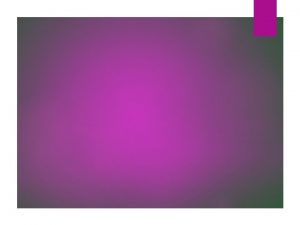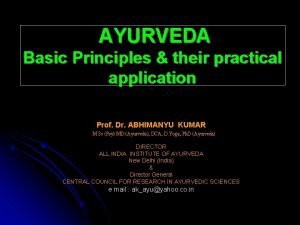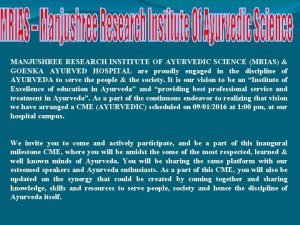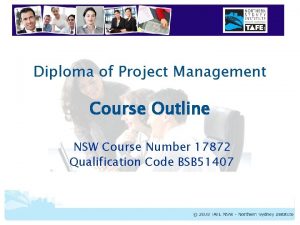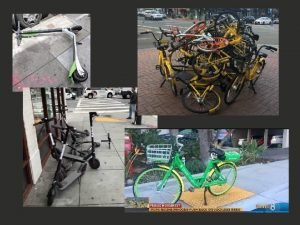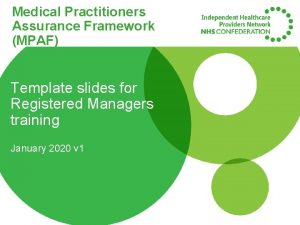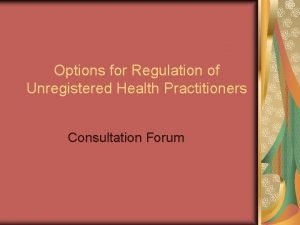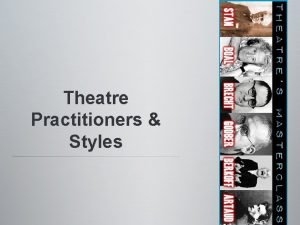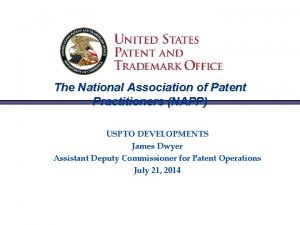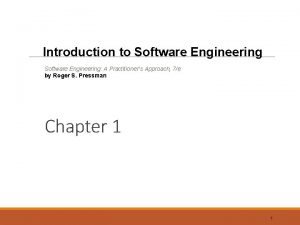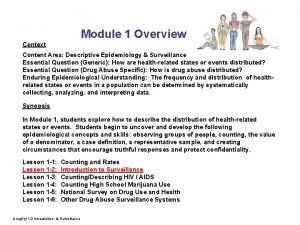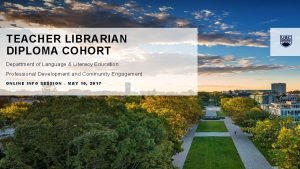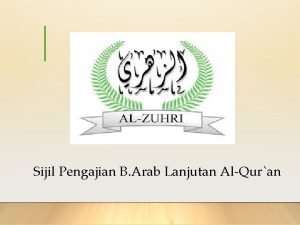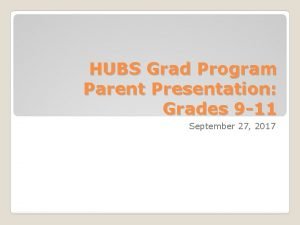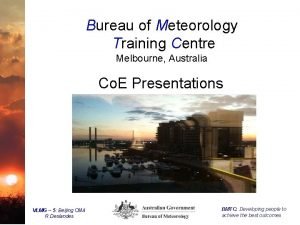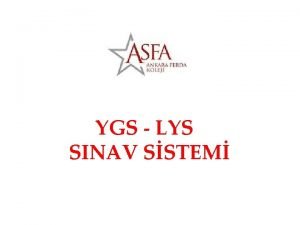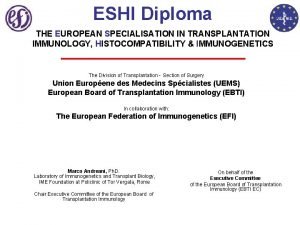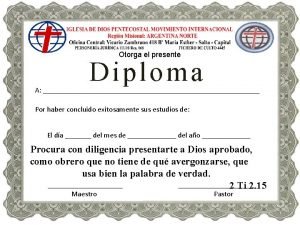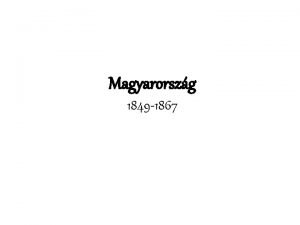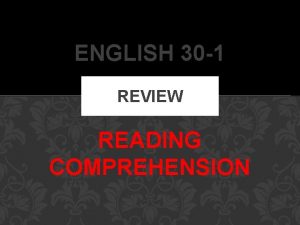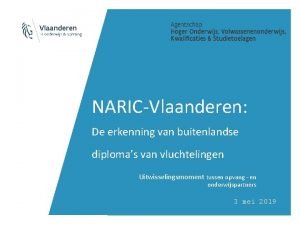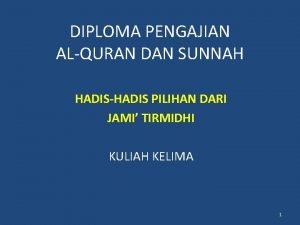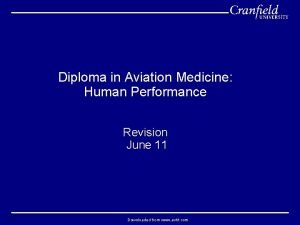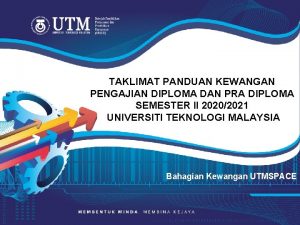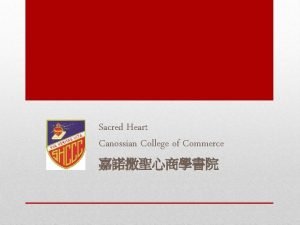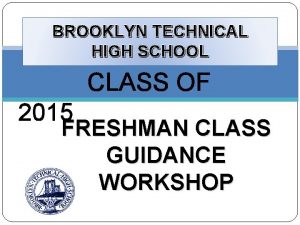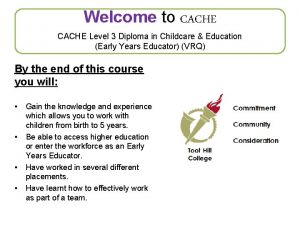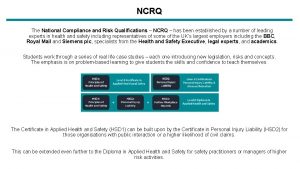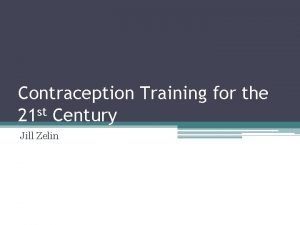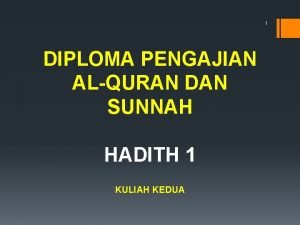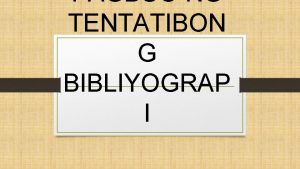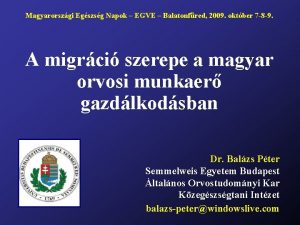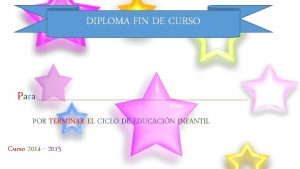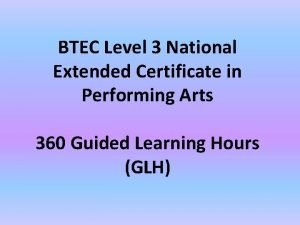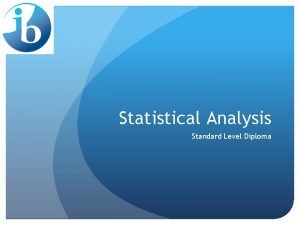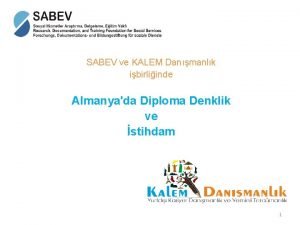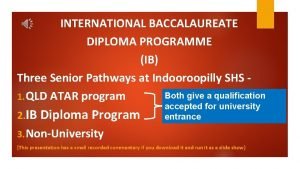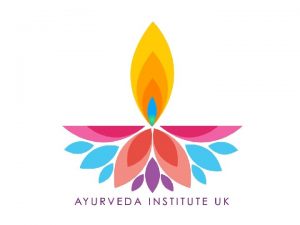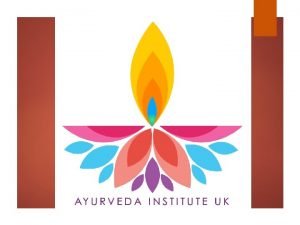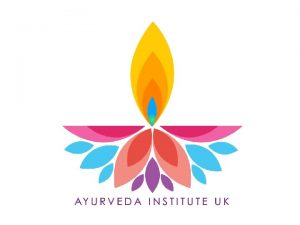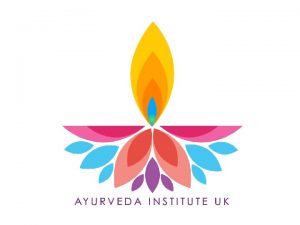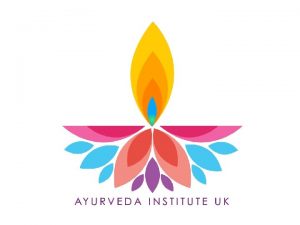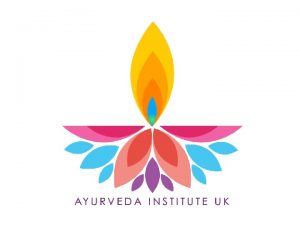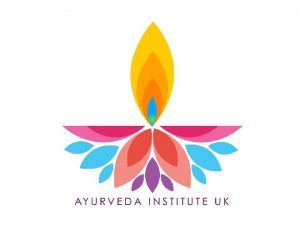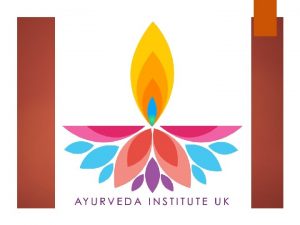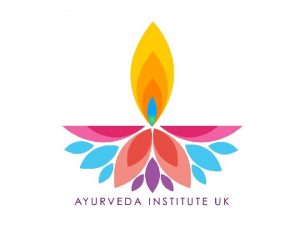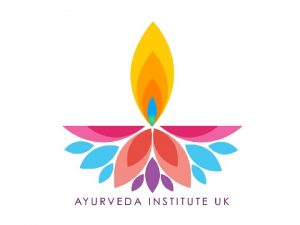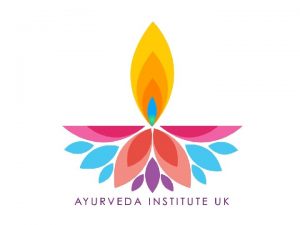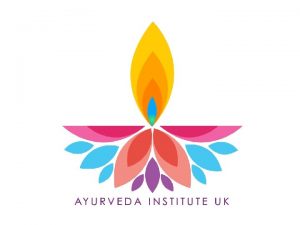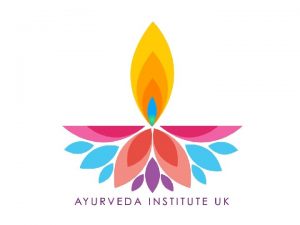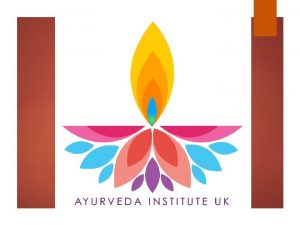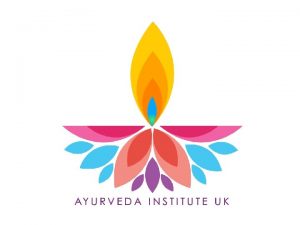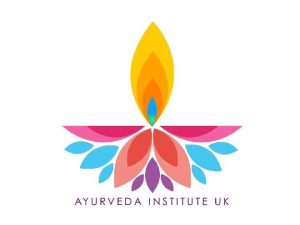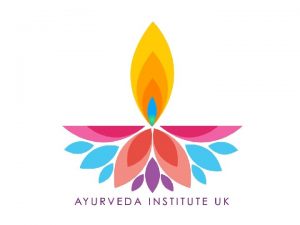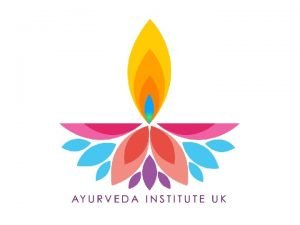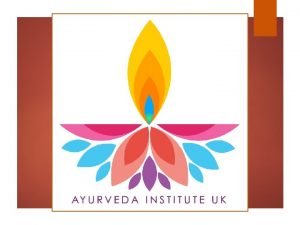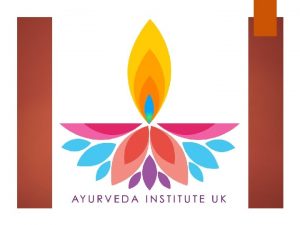DIPLOMA Ayurvedic Practitioners Course Module 4 7 th









































































- Slides: 73


DIPLOMA Ayurvedic Practitioners Course Module 4 7 th – 11 th December 2019 2

Arthritis The Ayurvedic perspective There are three main types of arthritis: • Ama vata (Rheumatoid arthritis) • Sandigata vata (Osteoarthritis) • Vata rakta (Gout) • In addition, psoriatic arthritis is a complication that can arise with the onset of psoriasis

Ama vata (Rheumatoid arthritis) The Allopathic perspective

Ama vata (Rheumatoid arthritis) The Allopathic perspective

Rheumatoid arthritis The Allopathic perspective • • RA is a long term condition Flare ups can occur from time to time There is no known cure Can be treated by modification of the disease and pain relief

Identifying the disorder The Allopathic perspective Signs & symptoms: • Joint pain • Rapid onset and spread of the disease • Swelling • Disability of the joints • Redness and hot to touch affected areas • Fever • Loss of appetite • Weakness of the body • Feeling unwell

Additional signs and symptoms The Allopathic perspective • • Poor appetite Weight loss Dry eyes Tiredness and lack of energy High temperature Chest pain Difficulty in breathing

Pathogenesis The Allopathic perspective • Considered to be an autoimmune disorder • Immune system mistakenly identifies joints as a foreign body and attacks • Results in inflammation in joints • Signs and symptoms appear • Long term attack by the immune system – joint can be completely disabled and destroyed

Causes The Allopathic perspective • • Causes unknown Women affected more than men Family history or genes Smoking

Importance of having treatment The Allopathic perspective • Disease can only be managed - there is no cure • Treatment prevents further damage • Must take medication long term to prevent complications • Risk of heart attack and strokes if medication not taken as prescribed • Complications – carpal tunnel syndrome – lung and chest pain – considered to be a life-threatening condition

Behaviour of the condition The Allopathic perspective • • • Incurable once condition appears Can remain dormant Even when dormant certain signs and symptoms continue Flare ups occur either once a month / few times a month / once every few years Timescales between flare ups is unpredictable Cause of flare ups is unknown During flare ups medications are re-considered or increased Regular appointments with Rheumatologist is required to discuss treatment Even in the absence of signs and symptoms of RA medication must be continued life-long

Affected areas of the body The Allopathic perspective • Joints • Starts with small joints and spreads to large joints • Cartilage • Ligaments • Tendons

Diagnosis & Treatment The Allopathic perspective • GP will carry out blood tests for ESR, CRP, full blood count, haemoglobin (anemia can appear in RA) • Without RF (CCP) arthritis can still be present • Even if you have symptoms without CCP treatment is still required • Due to the severity of the condition, high levels of medication are required

Investigation The Allopathic perspective • X-rays • Ultrasound scan • MRI

Medication and drugs The Allopathic perspective • No cure for RA • Essential treatments and supplements are lifelong • Medication • Surgery • Medications to prevent further damage to the joints • Treatments only limit the impact of the condition

Medicines The Allopathic perspective • DMARDS (Disease-modifying anti-rheumatic drugs) • Tablet form – – Methotrexate Leflunomide Hydroxychloroquine Sulfasalazine • Methotraxine side effects • • • feeling sick loss of appetite sore mouth Diarrheoa hair loss liver damage (regular blood tests needed to investigate liver)

Medicines The Allopathic perspective • Trials to find the correct DMARDS can take months and they take months to work • Until then need anti-inflammatory, anti-acid and painkillers

Biological treatments The Allopathic perspective • Such as chemotherapy – – – – – • • • etanercept infliximab adalimumab certolizumab golimumab rituximab abatacept tocilizumab sarilumab Always prescribed with DMARDS If not working, biological injections given in the affected areas Side effects – – – Skin irriation Infections Feeling sick High temp Headache Tuberculosis

Jak inhibitors The Allopathic perspective • Modern drug • Not found to be as successful as other treatments • To be taken with DMARDS • Side effects can be very serious

Pain killers The Allopathic perspective • NSAID – Ibuprofen – Naproxen – Diclofenac • Side effects are associated with prolonged use of these drugs

Corticoseteroids The Allopathic perspective • Prednisolone tablets and injections • While DMARDS taking effect, steroids are prescribed • Side effects – Weight gain – Osteoporosis – Bruising easily – Weakness of muscles – Thinning of skin

Other treatments The Allopathic perspective • Occupational therapy • Physiotherapy • Complementary medicine – Acupuncture – Massage – Chiropractic – Osteopathy

Diet and nutrition advice The Allopathic perspective “There's no strong evidence to suggest that specific dietary changes can help improve rheumatoid arthritis, although some people with rheumatoid arthritis feel their symptoms get worse after they've eaten certain foods. If you think this may be the case for you, it may be useful to try avoiding problematic foods for a few weeks to see if your symptoms improve. But it's important to ensure your overall diet is still healthy and balanced. ” • No evidence diet found to help • Avoiding food can relieve signs and symptoms for a while

Rheumatoid arthritis – Ama vata The Ayurvedic perspective Nidana • • Sedentary habits Low digestive fire Incompatible food Incompatible behaviour Incompatible thoughts Excess physical exercise / exhaustion Exercising immediately after having food As a result of these causes all three dosha can become vitiated and circulate throughout the body with the āma already created.

Samprapti The Ayurvedic perspective • As a result of the above causes, āma is created in the stomach • Āma travels into the upper part of the chest and the joints (due to vitiated vata) • The āma is fermented and thus has the specific qualities of pitta and vidagdha (acidic quality) • Āma with these specific pitta qualities is carried by the blood circulatory system • The āma comes to rest in vata and kapha sites in the body such as joints and synovial membranes

Samprapti The Ayurvedic perspective • The aggravated pitta over stimulates the immune system (ojas) • The immune system incorrectly identifies the vata, kapha and pitta āma as foreign bodies and attacks it • Causing inflammation in the joints and also fluid retention • Due to the acidic nature of pitta āma, joints can become eroded

Samprapti The Ayurvedic perspective • Āma vata tends to be attracted to the most mobile joints in the body, where vata predominates such as fingers, knees etc. • Kapha āma is attracted to joints because of the kapha nature of the synovial membrane.

Signs & Symptoms The Ayurvedic perspective Signs and symptoms vary depending on whether the patient is experiencing a flare up or the condition is dormant. Dormant • Pain • Thirst • Loss of appetite • Lethargy • Heaviness of the body • Feverish • Indigestion • Emptiness or looseness of the joints

Signs & Symptoms The Ayurvedic perspective During a flare up • • • • • Painful and sever condition All joints have severe, stabbing or pins and needles pain Swelling of the joints Severe loss of appetite and salivation Extreme heaviness of joints Lack of enthusiasm / feeling of hardship and excessive effort Bad taste in the mouth High temperature / fever / hotness of the body Urgency to urinate Pain in stomach Insomnia Sleepiness in daytime Dizziness Chest pain Constipation Bloating Sounds produced by stomach

Vata, pitta, kapha symptoms The Ayurvedic perspective Pitta symptoms • High temperature • Redness • Swelling • Irritation Vata symptoms • Severe pain spreading quickly • Looseness of joints Kapha symptoms • Itchiness of area • Heavy • Swollen • Fluid retention

Chikitsa The Ayurvedic perspective • Thorough dietary guidance is essential because this disorder involves tri-dosha. • Diet to be carefully considered according to the constitution of the person and the signs and symptoms • Eg. severe pain and swelling of the joints, focus should be on relieving pain and reducing the swelling – external applications such as oils to relieve pain – paste can be applied externally to draw out the heat and excess fluid from the joint – internally, eliminate āma producing food from diet – patient tends to exhibit behaviours, signs and symptoms related to their particular constitution

Chikitsa The Ayurvedic perspective • Langhana – fasting from certain foods – Pitta reducing diet initially • • Swedana Agni deepana Ama pachana Katu virechana (pungent purgatives) Sneha pana (ingestion of ghee / oil) Ruksha vasti (enema with decoction) Valuka sweda (hot sand poultices)

Medicine The Ayurvedic perspective External application • Dashanga lepa • Triphala choorna • Mahanayarana oil (for inflammation of tissue) • Pinda oil (for inflammation of tissue) • Sarshapadee oil (for cases where there is fluid retention)

Medicine The Ayurvedic perspective Agni deepana & ama pachana • Hingu ashtaka choorna • Bashkara lavana • Mani badhra • Paaka choorna • Coriander water Shodana • Triphala • Dhatri • Cumin & honey • Yoga raja guggul (anti-inflammatory and analgesic and muscle relaxant)

Sandigata vata (osteoarthritis) The Ayurvedic perspective

Sandigata vata (osteoarthritis)

Sandigata vata (osteoarthritis)

Osteoarthritis The Allopathic perspective Most common type of arthritis in the UK Signs and symptoms • Pain and Stiffness in joints • Swelling and inflammation • Signs and symptoms vary from person to person • Once diagnosed, it can remain as it is and in other cases can cause further damage

Causes The Allopathic perspective • Unknown causes Predictable causes • Joint injury • As a result of RA or gout • Ageing • Family history • Obesity

Diagnosis The Allopathic perspective • Over 50 • excessive use of joints • Morning stiffness lasting longer than 30 minutes • X-rays • Blood tests – can’t diagnose osteoarthritis with blood test but can rule out other conditions

Treatment The Allopathic perspective • • • No known cure Long term condition No known reason for progression or improvement Exercise can sometimes aggravate the condition Losing weight Regular exercise Wearing suitable footwear Painkillers Physiotherapy Surgery to replace joints

Prevention The Allopathic perspective Not possible to prevent Ways to minimise risk: • Avoid injury • Stay healthy as possible • 2 ½ hours aerobic exercises per week • Maintain good posture

Symptoms of further damage The Allopathic perspective • • • Joint tenderness Increased pain when moving joint Joint deformities Cracking sounds of the joints Limited joint movement Muscle wasting

Potential treatments The Allopathic perspective No known cure Lifestyle measures: • Exercise • Medication • Supportive therapies • Drug treatment – painkillers & NSAIDs • • • – such as ibuprofen, naproxen or diclofenac Inhibitors – COX-2 inhibitors Topical NSAIDs creams Antacids – proton pump inhibitors Opiods - codeine, paracetamol, tramadol, dihydrocodeine Capsaicin cream – causes burning sensation and pain – blocks the nerves that send pain messages Corticosteroid injections – control pain and inflammation – no more than 3 injections a year Visco supplementation – severe side effects – more research needed Transcutaneous electrical nerve stimulation (TENS) Therapies – hot / cold puches, manual massage therapy, surgery

Osteoarthritis & Osteoporosis • Osteoarthritis – degeneration of joints – painful condition • Osteoporosis – loss of bone mass / density which increases the risk of fractures even spontaneously – painless condition – pain experienced only when fractures occur – osteoporosis often only detected when a fracture occurs as there is no pain


Sandigata Vata - Osteoarthritis The Ayurvedic perspective Nidana • Ruksha (dry) sheeta (cold) laghu (light) alpa (insufficient) foods • Excessive sexual intercourse or sexual thoughts • Insufficient sleep over long period • Bad behaviour • Addiction to negative thoughts (scarcity complex) • Incorrect use of detox methods or addiction to detox • Excessive or unnecessary blood letting, vamana or phlegm letting • Excessive exercise, weight lifting

Osteoarthritis The Ayurvedic perspective • Dhatu sheena (caused by excessive exercise) • Excessive thinking / stress / anxiety / sadness leading to emaciation • Suppression of natural urges such as hunger, thirst, elimination which increases capacity for other nidhana • Accidents or assaults • Excessive or incorrect fasting • Horse, camel or elephant riding • Falling off vehicles

Samprapti The Ayurvedic perspective • • Vata becomes imbalanced vata is carried by the vata vaha srotas travels to vata sites such as bone tissue Dries the bone tissue making it light and brittle Happens especially at the ends of the bones Moisture absorbed from the synovial membrane also affects the delicate and subtle energies and emotions of vata and the vata qualities of the mind

Samprapti The Ayurvedic perspective • Mostly affects people in the vata stage of their lives • After 50 years old • Predominantly vata constitution are more prone to osteoarthritis • Occurs commonly during the menopause for women

Signs and symptoms The Ayurvedic perspective • • • Pain and stiffness in joints Lethargy Loss of appetite Feeling cold Cracking sounds in joints Bone deformity at the joints Limited range of movement in joints Pain in tendons Weakness or muscle wasting

Treatment The Ayurvedic perspective • Vata reducing diet and lifestyle (to be strictly followed) • Agni deepana • Vrunghana (rejuvenation) • Snehana (oleation) • Swedana (for cooling)

Medicine The Ayurvedic perspective External application • Mahanarayana oil • Sheera baladi oil • Kadum bidum oil • Pinda sweda soaked in warm coconut milk

Medicine The Ayurvedic perspective Internal • Triphala choorna • Hingu ashtaka • Cumin and honey • Ama hara or paaka choorna • Coriander water (for inflammatory conditions only) • Chayawanaprash • Kushmanda avaleha • Brahmi grita • Medicated ghee • Yoga raja guggul

Medicine The Ayurvedic perspective Shodana • Regular massage with Mahanarayana oil • Kati vasti • Janu vasti • Oil enema • Panchakarma

Vata rakta (gout)

Gout The Allopathic perspective • Can begin with sudden severe pain in the big toe • Fingers, wrists, elbows or knees can be affected • Uric acid is formed and deposited • Causes inflammation

Gout The Allopathic perspective Signs and symptoms • Pain in the joints • Redness • Heat • Swelling • High temperature

Gout The Allopathic perspective • Immediate attention needed to prevent further damage • Infection preceded by shivery fever • Can appear without reason

Gout The Allopathic perspective Causes • Not found • Smoking • Excess alcohol intake

Gout The Allopathic perspective Prevention from further attacks: • Stop smoking / drinking • Stop high protein diet • Lose weight • Drink lots of water • Take regular exercise • Take Vitamin C supplements • Reduce intake of red meat, kidneys, liver, seafood • Reduce intake of dairy products

Gout The Allopathic perspective Triggers • Stress • Illness • Injury or bruising of the joint

Gout The Allopathic perspective Who gets gout • Those with family history • Men, especially as they get older • Women after menopause • People who take diuretic medication • Those with high cholesterol • People who are overweight • Those that drink alcohol

Gout The Allopathic perspective Complications • Damage to the joint • Lumps under the skin called tophi • Lumps on ears, fingers, elbows • Kidney stones

Gout The Allopathic perspective Treatment • Anti-inflammatory drugs • Apply ice pack on affected area • Drink plenty of fluids • Relax and relieve stress • NSAIDS • Corticosteroids • Allopurinol • Febuxostat

Gout The Ayurvedic perspective Nidana • • • • • Pungent, astringent and sour foods Pitta increasing foods Heating foods such as vinegar, mustard and tomatoes Salty foods Oily and fried foods Foods that are difficult to digest such as dairy and cheese Fermented food Pickled and preserved foods Very dry foods such as dried meats and fish Red meat and red fish Horseradish and root vegetables Raw foods sugar yoghurt smoking alcohol incompatible food emotions of hatred anger

Samprapti The Ayurvedic perspective • Sedentary workers eating rich and sour foods • Creates heat and pitta ama (toxins or uric acid) very quickly • Pitta ama circulates through the rakta vaha srotas • Deposited in the extremities • Further pitta aggravation occurs, joints of the extremities become inflamed

Signs and symptoms The Ayurvedic perspective sweating feeling hot goosebumps patches of discolouration over the whole body numbness in the body severe pain looseness of the joints feeling unwell / feverish spots of itchiness and redness in hips, shoulders, groin, arms and legs • stabbing pain in big toe • muscle spasm • heaviness of the body • • •

Treatment The Ayurvedic perspective External applications are important to draw the heat from the affected area and give immediate relief. • Ice pack / cold water • Dermaved • Neelyadi oil • Pinda oil • Kumari oil • Moringa leaf paste • Triphala paste • Dashanga lepa paste • Dermaved Red

Treatment The Ayurvedic perspective Internal • Pitta reducing diet • Nimbadhi choorna • Chandanadi choorna • Triphala choorna • Coriander water • Cumin and honey • Medicated ghee (pancha tiktaka grita) • Hingu ashtaka • Dhatri • Kayshora guggul

Autoimmune disorders • • • • • • • • • • • Addison’s disease Agammaglobulinemia Alopecia areata Amyloidosis Ankylosing spondylitis Anti-GBM/Anti-TBM nephritis Antiphospholipid syndrome Autoimmune angioedema Autoimmune dysautonomia Autoimmune encephalomyelitis Autoimmune hepatitis Autoimmune inner ear disease (AIED) Autoimmune myocarditis Autoimmune pancreatitis Autoimmune retinopathy Autoimmune urticaria Axonal & neuronal neuropathy (AMAN) Baló disease Behcet’s disease Benign mucosal pemphigoid Bullous pemphigoid Castleman disease (CD) Celiac disease Chagas disease Chronic inflammatory demyelinating polyneuropathy (CIDP) Chronic recurrent multifocal osteomyelitis (CRMO) Churg-Strauss Cicatricial pemphigoid Cogan’s syndrome Cold agglutinin disease Congenital heart block Coxsackie myocarditis CREST syndrome Crohn’s disease Dermatitis herpetiformis Dermatomyositis Devic’s disease (neuromyelitis optica) Discoid lupus Dressler’s syndrome Endometriosis Eosinophilic esophagitis (Eo. E) Eosinophilic fasciitis Erythema nodosum Essential mixed cryoglobulinemia • • • • • • • • • Evans syndrome Fibromyalgia Fibrosing alveolitis Giant cell arteritis (temporal arteritis) Giant cell myocarditis Glomerulonephritis Goodpasture’s syndrome Granulomatosis with Polyangiitis Graves’ disease Guillain-Barre syndrome Hashimoto’s thyroiditis Hemolytic anemia Henoch-Schonlein purpura (HSP) Herpes gestationis or pemphigoid gestationis (PG) Hypogammalglobulinemia Ig. A Nephropathy Ig. G 4 -related sclerosing disease Immune thrombocytopenic purpura (ITP) Inclusion body myositis (IBM) Interstitial cystitis (IC) Juvenile arthritis Juvenile diabetes (Type 1 diabetes) Juvenile myositis (JM) Kawasaki disease Lambert-Eaton syndrome Leukocytoclastic vasculitis Lichen planus Lichen sclerosus Ligneous conjunctivitis Linear Ig. A disease (LAD) Lupus Lyme disease chronic Meniere’s disease Microscopic polyangiitis (MPA) Mixed connective tissue disease (MCTD)

• • • • • • • • • • Mooren’s ulcer Mucha-Habermann disease Multiple sclerosis Myasthenia gravis Myositis Narcolepsy Neuromyelitis optica Neutropenia Ocular cicatricial pemphigoid Optic neuritis Palindromic rheumatism (PR) PANDAS Paraneoplastic cerebellar degeneration (PCD) Paroxysmal nocturnal hemoglobinuria (PNH) Parry Romberg syndrome Pars planitis (peripheral uveitis) Parsonnage-Turner syndrome, Pemphigus Peripheral neuropathy Perivenous encephalomyelitis Pernicious anemia (PA) POEMS syndrome Polyarteritis nodosa Polyglandular syndromes type I, III Polymyalgia rheumatica Polymyositis Postmyocardial infarction syndrome Postpericardiotomy syndrome Primary biliary cirrhosis Primary sclerosing cholangitis Progesterone dermatitis Psoriasis Psoriatic arthritis Pure red cell aplasia (PRCA) Pyoderma gangrenosum Raynaud’s phenomenon Reactive Arthritis Reflex sympathetic dystrophy • • • • • • • Relapsing polychondritis Restless legs syndrome (RLS) Retroperitoneal fibrosis Rheumatic fever Rheumatoid arthritis Sarcoidosis Schmidt syndrome Scleritis Scleroderma Sjogren’s syndrome Sperm & testicular autoimmunity Stiff person syndrome (SPS) Subacute bacterial endocarditis (SBE) Susac’s syndrome Sympathetic ophthalmia (SO) Takayasu’s arteritis Temporal arteritis/Giant cell arteritis Thrombocytopenic purpura (TTP) Tolosa-Hunt syndrome (THS) Transverse myelitis Type 1 diabetes Ulcerative colitis (UC) Undifferentiated connective tissue disease (UCTD) Uveitis Vasculitis Vitiligo Wegener’s granulomatosis (or Granulomatosis with Polyangiitis (GPA)
 Ayurvedic lifestyle consultant
Ayurvedic lifestyle consultant Clean in
Clean in Manjushree research institute of ayurvedic science
Manjushree research institute of ayurvedic science Bsb51407
Bsb51407 Curbside management practitioners guide
Curbside management practitioners guide Mpaf
Mpaf Association of independent insolvency practitioners
Association of independent insolvency practitioners Unregistered health practitioners
Unregistered health practitioners Theatre practitioner
Theatre practitioner Kimber dita for practitioners volume 1 download
Kimber dita for practitioners volume 1 download Australian college of nurse practitioners
Australian college of nurse practitioners Social business practitioners
Social business practitioners Ecd progress report
Ecd progress report Tax practitioners association indore
Tax practitioners association indore National association of patent practitioners
National association of patent practitioners Software engineering a practitioners approach
Software engineering a practitioners approach C device module module 1
C device module module 1 Situational frontline leadership
Situational frontline leadership Course module sample
Course module sample Chaine parallèle muscle
Chaine parallèle muscle Stretcher bond t junction
Stretcher bond t junction Course title and course number
Course title and course number Ubc teacher librarianship
Ubc teacher librarianship Pengajian alquran
Pengajian alquran Dogwood diploma
Dogwood diploma What is a scholar diploma
What is a scholar diploma Ib diploma requirements
Ib diploma requirements Reg pm diploma aipm
Reg pm diploma aipm Ib diploma requirements 2021
Ib diploma requirements 2021 Bureau of meteorology training centre
Bureau of meteorology training centre Ygs lys sınav sistemi
Ygs lys sınav sistemi Level 4 dance teaching qualification
Level 4 dance teaching qualification Immunology diploma
Immunology diploma Se otorga el presente diploma
Se otorga el presente diploma Oktoberi diploma
Oktoberi diploma English 30-1 diploma reading comprehension practice
English 30-1 diploma reading comprehension practice Naric dossier opvolgen
Naric dossier opvolgen Pengajaran hadis
Pengajaran hadis Diploma in funeral arranging and administration
Diploma in funeral arranging and administration Pearson btec level 3 national extended diploma
Pearson btec level 3 national extended diploma Grci course calendar
Grci course calendar American diploma project
American diploma project Diploma fin de curso primaria
Diploma fin de curso primaria Aviation medicine diploma
Aviation medicine diploma Elearning utmspace
Elearning utmspace 嘉諾撒聖心商學書院
嘉諾撒聖心商學書院 Hkdse full name
Hkdse full name Nostrification of high school diploma
Nostrification of high school diploma Diploma a super mama
Diploma a super mama Grand canyon diploma
Grand canyon diploma Grade 9 diploma
Grade 9 diploma Bths prefect list
Bths prefect list Ia resp diploma
Ia resp diploma Cache level 3 diploma in childcare and education
Cache level 3 diploma in childcare and education Diploma in reproductive medicine
Diploma in reproductive medicine Diploma sejarah & tamadun islam
Diploma sejarah & tamadun islam Ncrq hsd2 assignment 1
Ncrq hsd2 assignment 1 International skills diploma seal presentation
International skills diploma seal presentation Fsrh diploma cost
Fsrh diploma cost Lmi4all
Lmi4all Ia resp diploma plan
Ia resp diploma plan Diploma al quran dan sunnah
Diploma al quran dan sunnah Apa format tagalog halimbawa
Apa format tagalog halimbawa Orvosi diploma honositasa magyarorszagon
Orvosi diploma honositasa magyarorszagon Diploma fin curso
Diploma fin curso Unit 3 group performance workshop
Unit 3 group performance workshop Diploma supplement nedir
Diploma supplement nedir Diploma grade 10
Diploma grade 10 Diploma in statistics
Diploma in statistics Sabev nedir
Sabev nedir Baccalaureate diploma
Baccalaureate diploma Golden state seal merit diploma
Golden state seal merit diploma Online culinology degree
Online culinology degree Diploma in funeral arranging and administration
Diploma in funeral arranging and administration
